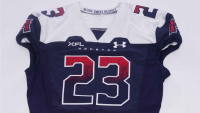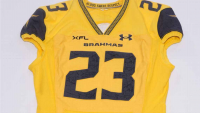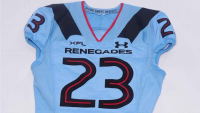I’d like to see them succeed enough to merge at some point.
Can the XFL and USFL coexist or is a merger in the offing?
By
Daniel Kaplan and
Bill Shea
Jul 29, 2022
Are you ready for … a lot of mid-tier pro football?
One week after the Super Bowl in February 2023, U.S. sports will see the unlikely scenario of five and a half straight months of startup spring football leagues, testing just how much American appetite there is for pigskin and whether that many quality football players aren’t on
NFL rosters.
The XFL, the third version of the league following a single 2001 season and half of one in 2020, unveiled its eight team markets earlier this week and committed to a Feb. 18, 2023, kickoff, broadcast by ESPN.
The XFL announced its eight host cities on Sunday night for the 2023 season.

️ Arlington

️ Houston

️ Orlando

️ Las Vegas

️ San Antonio

️ Seattle

️ St. Louis

️ Washington D.C.
The league dropped New York, Los Angeles and Tampa Bay.
https://t.co/Zjx5XQnKhz
— The Athletic (@TheAthletic)
July 25, 2022
About two months into that roughly 10-week run, which includes a postseason, the second campaign of the rejiggered USFL gets underway. It promises to stretch the uninterrupted skein of spring football into July, just weeks before the NFL returns for training camps.
“There’s clearly an appetite for year-round football. I don’t think that’s in question,” said Randy Vataha, a former New England Patriot who owned an original USFL team and is a longtime sports investment banker. “I think that the level of the appetite, especially if you’re putting on two leagues, is tough. … But it’s always been the question of can you generate enough revenue to support the sport of football?”
Vataha predicts that within a few years, the leagues will merge if one has not folded. “If they both get some level of establishment,” he said, “you can pretty much be guaranteed there’ll be merger talks pretty early on.”
By now it’s a broken record, but it’s worth repeating: Non-NFL football leagues are typically short-lived affairs, out of the gate with hype about the unending hunger for football, then collapsing under a barrage of headlines about economic difficulties.
The original XFL crashed after the 2001 season — it lost a reported $70 million — and was brought back in 2020 by wrestling titan Vince McMahon, who shut it down weeks into the pandemic despite spending over $200 million. In 2019, the Alliance of American Football shuttered after two months into its inaugural season, filing for bankruptcy after a severe mismatch between revenues and expenses.
This followed the FXFL and the United Football League, failed leagues in the 2010s.
“The problem for all spring or startup football leagues like the UFL is what’s the revenue model?” said Michael Huyghue, who was the commissioner of the UFL, which lasted three seasons. “And it’s one thing to come out of the gate and say there are no saturation issues and people still have a thirst for football. But getting paid attendance alone isn’t even going to really drive it. College football and the NFL, of course, are driven monumentally by their television deals.
“And that’s why so much movement is happening within the conferences and everything else is everyone’s chasing the most lucrative television deals. … You need, ultimately, that kind of revenue stream to be sustainable.”
Providing content
There are signs that the USFL and XFL could break free of the revenue hurdle. For one, the USFL is owned by Fox Sports, which views the league as model filler programming when it needs to fill airtime. Average ratings in the first season were passable at nearly 700,000 viewers per game, with several games topping 1 million or more viewers on broadcast TV.
Fox has also reportedly earmarked $150 million to finance the league’s first few seasons.
“Is there room for two? It’s hard to say. As the standard for success gets lower, it’s hard to suggest there isn’t room for more,” said Jon Lewis, who runs Sports Media Watch, which tracks TV viewership and ratings. “If you can get 300,000 for each game on cable, maybe 500,000 or 600,000 on broadcast … I don’t know if that’s thriving, but you can survive on that.”
In the age of cord-cutting, TV networks have turned to streaming to build an audience long-term. That makes content vital, and the USFL and XFL can be considered relatively cheap content that delivers decent viewership in a slower period of the sports calendar.
“It’s inventory now for streaming channels. It’s going to be content for them. Maybe that gives them more cushion to survive,” Lewis said.
One element that’s not been much of a factor is football players. The original USFL of the mid-1980s directly challenged the NFL’s homogeny and spent itself into oblivion but is nostalgically remembered by older football fans for producing a batch of future NFL stars and Hall of Famers.
These leagues are lower-tier — Fox, NBC and ESPN are not going to risk the NFL golden goose by challenging it — so there is little expectation that they’ll produce a new wave of Reggie Whites, Jim Kellys and Steve Youngs.
After its recently completed season, 22 USFL players have signed on to NFL teams (how many stick with the clubs is the big question).
The new XFL has the weight of ESPN behind it. When the league announced its eight home markets, ESPN sent out a push notification. The parties won’t comment on the economics of the deal, but a source said there is a rights fee.
“There is substantial income from day one,” the source texted of the ESPN contract, who then compared the league’s strategy to the 2020 startup version. “But every aspect of the overall plan is better, from the way they will leverage their new owners (which include Dwayne “The Rock” Johnson) … to the way they see the game being played, to the TV deals, to the marketplaces they chose, to the way they’re housing players, to fan engagement plans.”
In addition to Johnson, the league is owned by his former wife, Dany Garcia, and RedBird Capital. The trio bought the XFL out of bankruptcy for $15 million.
Much of their strategy has not been publicized yet. One element that has is that although the XFL will play in eight markets, all teams will train and spend the work week in Arlington, Texas. That’s a middle ground between a standard league structure and the USFL, which played all but its three playoff games in Birmingham, Ala.
Attracting the fans
USFL games were often mocked on social media for the lack of fans, a depressing tableau that made for a mediocre TV experience despite some technical innovations like drone cams during plays. During the pandemic, live sports TV viewership declined in part because fans were turned off by games in empty stadiums.
“Ultimately, I would question the viability of a league that was strictly sort of fan-baseless in cities, you know? It’s just a media product, period,” Vataha said.
The USFL has said it hopes to introduce a second hub city in 2023.
“Being in-market provides a certain amount of legitimacy that playing in neutral areas does not,” Lewis said. “That’s not a great TV visual. For the XFL to be in home markets is a great decision in making it seem like a real league.”
The eight XFL cities are Arlington, Houston, Las Vegas, Seattle, Orlando, San Antonio, St. Louis and Washington, D.C.
Though the XFL teams will not be present in their markets midweek, the league said each team would have an on-the-ground business staff marketing and selling tickets. The USFL did not do that in 2022.
The teams in 2020 that were successful in the short-lived XFL season had strong grassroots marketing staffs. The St. Louis BattleHawks, arguably the most advanced of the eight teams, held weekly fan events in the months leading up to the season, with an intense outreach to high schools and other local institutions.
“The fan base seems like it is still really strong, and I hope they set up some meet-and-greets around town,” said Mike Presson, a fan of the BattleHawks who attended many of the team’s fan events in 2019 and 2020, when asked about the reception to the news the XFL would return to the gateway city. Like many in St. Louis, he expressed hope the league would retain the BattleHawks name and logo.
The current ownership acquired the intellectual property as part of its purchase of the league out of bankruptcy, so it has rights to the BattleHawks name and imagery.
Roads to profitability
The viability of both football leagues will come down to live-game viewership and advertising dollars for the networks and cost controls by the organizers.
That’s a major question heading into 2023: Will there be enough ad dollars for both football leagues? This year, USFL games generated about $65 million in TV advertising revenue for Fox and NBC, according to EDO, a New York City-based advertising metrics data firm that tracks commercial engagement.
In 2020, ads during XFL games ginned up $50 million during the truncated season but were more effective than USFL in-game ads, the firm said.
“EDO data shows that TV viewers were 30 percent more engaged with ads during the shortened XFL season in 2020 than the USFL in 2022. However, advertisers might be wondering if the XFL will continue to carry as much weight now that the spring football schedule is denser with both leagues airing games around the same time,” said Laura Grover, EDO’s senior vice president and head of client solutions, via email.
Advertisers might opt to spend on commercials with both leagues.
“While brands will certainly manage their overall ad frequency during XFL and USFL games, there’s no known downside to investing in both environments,” Grover said. “Airing head-to-head ads will undoubtedly impact brands’ performance, but going into the season, we expect XFL has an advantage, given it has proven to be a stronger environment for advertisers.”
Though both football leagues are lower-tier sports properties the networks see as eyeball magnets with modest costs during a slower time of the year, they still are expected to at least break even or not cost backers a lot. Sponsorship dollars, TV commercial revenue and ticket and merchandise sales are all part of that matrix.
Said former Fox executive Patrick Crakes: “Is there enough sponsorship money to go around? I think there is.”
That said, the fate of both leagues hinges on what their undisclosed internal success metrics look like and the patience of network executives to allow the properties to grow before pulling the plug.
“They got some content; they’re not spending a ton of money,” Crakes said. “Everyone has to be patient, even if they have solid viewership and sponsorship.”
How the XFL and USFL execute their strategies and control expenses while maintaining a quality product will be key, he continued.
Playing games in eight markets will add significant operational costs, such as venue rental, travel, housing, etc.
“That becomes a cost you have to cover, and it can become really big really fast,” Crakes said. “The problem for any new league is venue costs. They’re very expensive.”
Because the XFL isn’t owned by Disney/ESPN, there could be additional pressure to turn a profit that the USFL doesn’t face because it’s owned by Fox. However, Fox has to justify the expenditures to its shareholders.
In the end, the networks and investors will either enjoy low-cost content or pull the plug. Crakes is guardedly optimistic because neither league is billed as anything more than it is and certainly isn’t pitted as an NFL alternative.
“There are lots of roads to profitability,” he said. “There is absolutely room for both leagues. This is going to be an execution story.”







